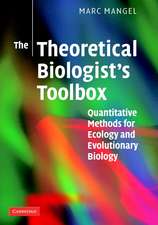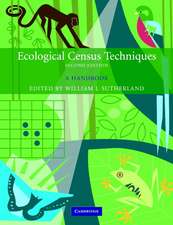Genes in Ecology: 33rd Symposium of the British Ecological Society: Symposia of the British Ecological Society
Editat de R. J. Berry, T. J. Crawford, G. M. Hewitten Limba Engleză Paperback – 31 iul 1992
Preț: 457.44 lei
Preț vechi: 513.98 lei
-11% Nou
Puncte Express: 686
Preț estimativ în valută:
87.54€ • 91.06$ • 72.27£
87.54€ • 91.06$ • 72.27£
Carte tipărită la comandă
Livrare economică 15-29 aprilie
Preluare comenzi: 021 569.72.76
Specificații
ISBN-13: 9780521549363
ISBN-10: 0521549361
Pagini: 548
Ilustrații: 105 b/w illus. 19 tables
Dimensiuni: 156 x 234 x 28 mm
Greutate: 0.76 kg
Editura: Cambridge University Press
Colecția Cambridge University Press
Seria Symposia of the British Ecological Society
Locul publicării:Cambridge, United Kingdom
ISBN-10: 0521549361
Pagini: 548
Ilustrații: 105 b/w illus. 19 tables
Dimensiuni: 156 x 234 x 28 mm
Greutate: 0.76 kg
Editura: Cambridge University Press
Colecția Cambridge University Press
Seria Symposia of the British Ecological Society
Locul publicării:Cambridge, United Kingdom
Cuprins
Part 1. Genes in Ecology: 1. Genes and ecology in history A. J. Cain and W. B. Provine; 2. Stochastic processes in populations: the horse behind the cart? J. R. G. Turner; 3. Population dynamics, natural selection and chaos H. C. J. Godfray, L. M. Cook and M. P. Hassell; 4. Life-history evolution R. Sibly and J. Antonovics; 5. These hierarchical views of life: phylogenies and metapopulations P. H. Harvey, S. Nee, A. Ø. Mooers and L. Partridge; 6. The coevolution of plant-insect and host-parasite relationships D. J. Futuyma and R. M. May; Part II. Molecules in Ecology: 7. Adaptation in bacteria: unanswered ecological and evolutionary questions about well-studied molecules J. P. W. Young and B. R. Levin; 8. Enzymes and adaptation A. G. Clark and R. K. Koehn; 9. Molecular variation and ecological problems T. Burke, W. E. Rainey and T. J. White; 10. Ecological genetics of parasitism R. Ennos; 11. Genes and ecology: two alternative perspectives using Drosophila M. Kreitman, B. Shorrocks and C. Dytham; Part III. Ecology in Genetics: 12. Genetic heterogeneity and ecology J. A. Endler; 13. Density and frequency dependence in ecology: messages for genetics? M. Begon; 14. Density and frequency dependence: a genetical view B. C. Clarke and M. A. Beaumont; 15. Functional biology of adaptation M. E. Feder and W. B. Watt; 16. Life history and mechanical constraints on reproduction in genes, cells and waterfleas J. S. Jones, D. Ebert and S. C. Stearns; 17. Conservation biology: the ecology and genetics of endangered species A. P. Dobson, G. M. Mace, J. Poole and R. A. Brett; 18. Genes in the real world R. J. Berry and A. D. Bradshaw; Part IV. Techniques and Protocols: 19. Use of PCR techniques in Drosophila population biology L. O'Brien, D. Coates, J. Arnold and B. Shorrocks; 20. Polymerase chain reactions I. Arnau and S. Cooper; 21. The detection of organisms at family, genus and species level using the polymerase chain reaction to amplify specific target DNA sequences R. A. McKee, C. M. Gooding, S. D. Garrett and H. A. Powell; 22. Selection of DNA sequences for use as probes R. A. McKee, C. M. Gooding, S. D. Garrett, H. A. Powell, B. M. Lund and M. R. Knox; 23. RAPDs: random amplified polymorphic DNAs D. Howland and J. Arnau; 24. DNA fingerprinting R. E. Carter; 25. DNA fingerprinting using multilocus and single locus probes R. E. Carter and D. T. Parkin; 26. Fingerprinting fungi P. Nicolson, J. Brown and M. Atkinson; 27. Analysis of genetic variation in populations: southern blotting and restriction fragment length polymorphism (RFLP) analysis S. Noble, R. Oliver and A. Davy; 28. The use of repetitive DNA probes in the analysis of natural populations of insects and parasites P. K. Flook, M. D. Wilson and R. J. Post; 29. C-banding and the characterization of heterochromatic regions J. M. Rubio and C. Ferris; 30. Silver staining C. Ferris and J. M. Rubio; 31. Use of a cellulose acetate system for allozyme electrophoresis I. R. Wynne, H. D. Loxdale and C. P. Brookes; 32. A device for producing multiple deep-frozen samples for allozyme electrophoresis I. R. Wynne and C. P. Brookes.
Descriere
Geneticists and ecologists confront the implications of the others' discipline for their own work.





















